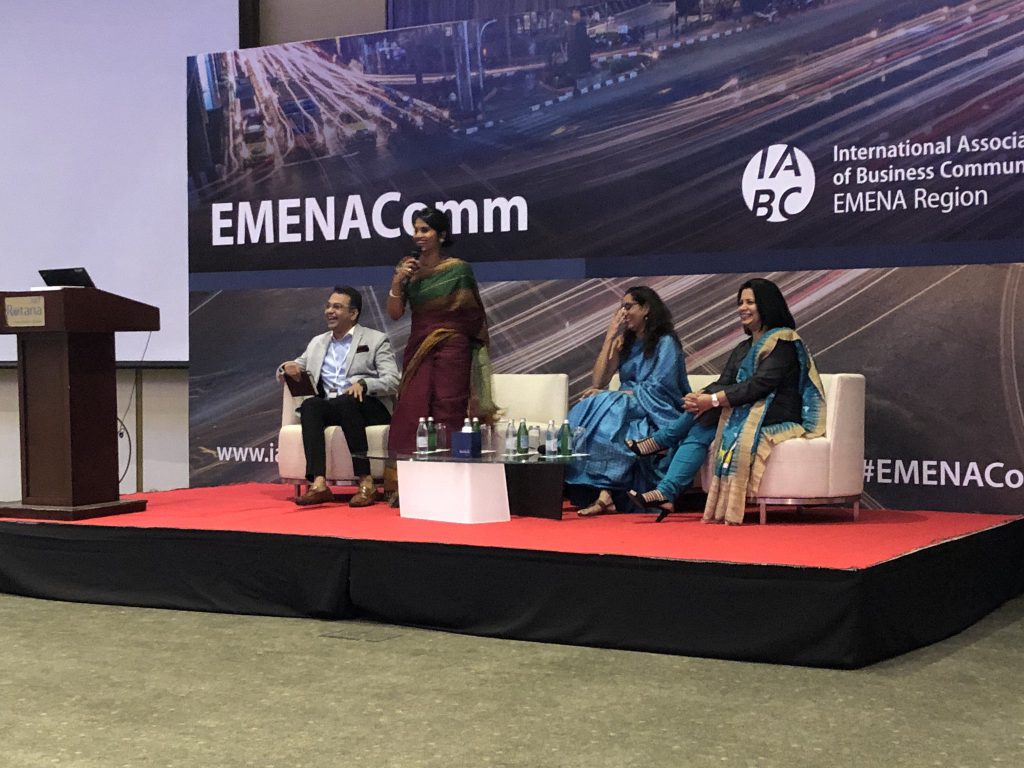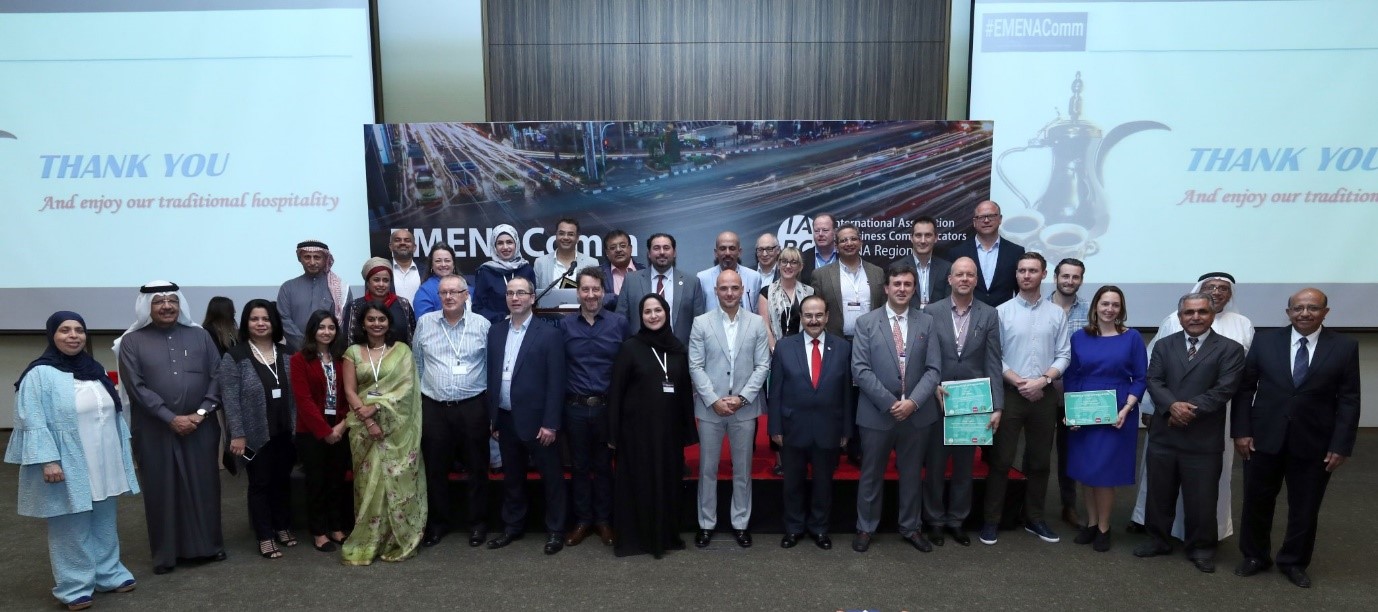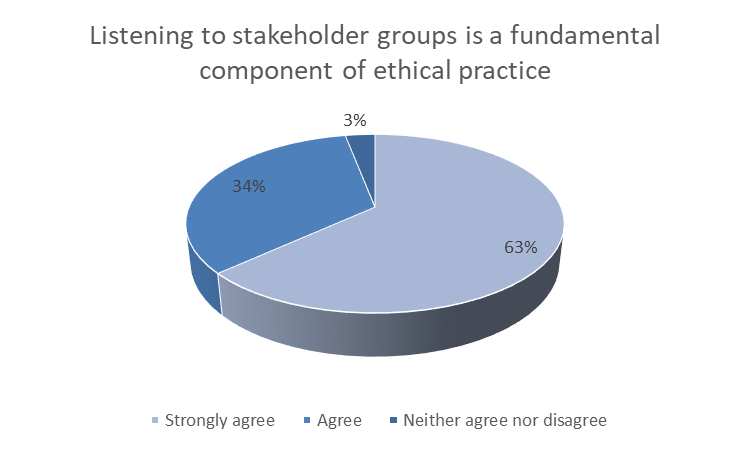Purpose, internal comms and listening at EMENAComm 2019

About the author
Kevin is a co-founder of PR Academy and editor/co-author of Exploring Internal Communication published by Routledge. Kevin leads the CIPR Internal Communication Diploma course. PhD, MBA, BA Hons, PGCE, FCIPR, CMgr, MCMI.

The official theme for EMENAComm which took place in Bahrain on 11 and 12 February was transformation. But what emerged from many presentations was that this often comes back to purpose, internal communication and listening.
The conference, organised by Alex Malouf (a past PR Academy student), attracted speakers and delegates from across the Gulf, Australia, India, Europe and the US. What struck me in presentations from all these regions is how similar some of the challenges are today. For example, moving from tactics to a more strategic approach was a common theme.

Delegates and speakers at EMENAComm 2019 in Bahrain with the Minister for Water and Electricity
Purpose
Klavs Valskov from Frankly provided an illuminating case study of the development of a purpose-led brand that evolved from the merger of GE Oil and Gas and Baker Hughes. This included the coining of a completely new term for the industry “Fullstream” to position the new company as providing a full- service offer. Klavs highlighted the importance of finding your unique attributes in a merger situation. He also talked about a messaging framework that incorporates four elements: purpose, pillars, promise and proof.
Lewis Woodward highlighted the importance of EY’s purpose; ‘Developing a Better Working World’, which he said guides everything. Colin Hatfield referred to the latest Edelman Trust Barometer report which included purpose and values as drivers of trust.
Internal communication
Although this was not a conference about internal communication per se, it was notable that many presentations acknowledged the growing importance of the specialism for successful organisations. Joss Mathieson talked about the way that GSK put employees at the heart of their new strategy. He stressed the critical linkage of communication to involvement and engagement. Colin Hatfield focused on leadership communication, which includes them moving into their ‘discomfort zone’ which is about culture, vision and values rather than the ‘comfort zone’ of business models, processes and strategy. His manifesto for leadership communication stressed three points:
- Leadership communication is different from manager communication
- Leaders need to be honest with themselves
- Create a ‘communication department’ in every leader
Daniel Penton talked about the way that internal communication planning remains too focused on channel stacks, rather than business objectives. Darren Briggs from Flametree notably observed that we are now very used to targeted communication in our personal lives but we are still a long way from that at work where we often rely on ‘all employee’ email briefings. He has developed a useful looking ‘Leadership Conversation Indicator’ which enables internal communication planning to be focused on key communication weaknesses.
The focus on leadership communication is a welcome development as practitioners increasingly realise that this is potentially a more useful aspect of effective internal corporate communication strategy than line manager communication.
Although it is, of course, important not to reduce the role of leadership communication to false or overtly trained ‘presence’ or behaving like a games show host on speed in a vain attempt to ‘inspire’ employees who are generally simply seeking straightforward, human, jargon-free, personable communication.
Listening
The importance of listening to employees was cited in several presentations and it was also the subject of a workshop that I ran with Mike Pounsford and Howard Krais (past and present chairs of IABC UK).
According to Joss Mathieson when the new CEO, Emma Walmsley, was appointed at GSK she started with a listening tour of the company. They also ran a #Letstalk initiative that was linked to innovation, performance and trust. As part of EY’s ‘Better Working World’ purpose, the company gave people space to talk and introduced a ‘Better Question Time’ where the CEO answered queries personally. And Colin Hatfield stressed that leaders should help employees feel that they contribute and to do this they should value their input.
In the listening workshop, we revealed some of the results from a recent ‘listening to stakeholders’ survey. Key points that have emerged from the initial data analysis are:
- Building trust with stakeholder groups is valued by organisations with 52% of respondents stating it is ‘highly valued’
- Listening to external stakeholder groups is valued more highly than listening to employees (44% versus 31% respondents stating ‘highly valued’)
- Social channels and face to face meetings are the most used approaches for listening to external stakeholders
- Face to face meetings and surveys are the most used approaches for listening to employees and, notably, less than half of respondents are using internal social channels for listening to employees
- Only 16% of respondents strongly agreed that senior managers are willing to listen to what employees have to say and only 13% strongly agreed that senior managers take what employees say seriously.
There was also strong agreement that listening to stakeholder groups is a fundamental component of ethical practice.

This work is a small-scale piece of research based on 140 respondents. It is not therefore generalisable to the whole communication management field. It does, however, provide a useful snapshot of what some people think about listening. Further analysis of the data and open comments will be carried out and a report published in April.
The workshop discussions highlighted a number of points for further consideration. These include anonymity for employees in online chats, managers going to employees (rather than employees going to head office sessions), choosing tools to match the context of the discussion and using multiple tools in a consistent way on an ongoing basis. Putting listening into good and ethical internal communication practice is reflected in the AVID framework that evolved from my PhD research.
Mike, Howard and myself are now developing a listening workshop in London in the Spring which will explore the themes outlined here in more detail.
Note: this piece is not intended to be a thorough review of the conference – it is based purely on personal observations from some of the sessions attended out of the various options available throughout the two days. Go to #EMENAComm to check out what other people were saying about the event.